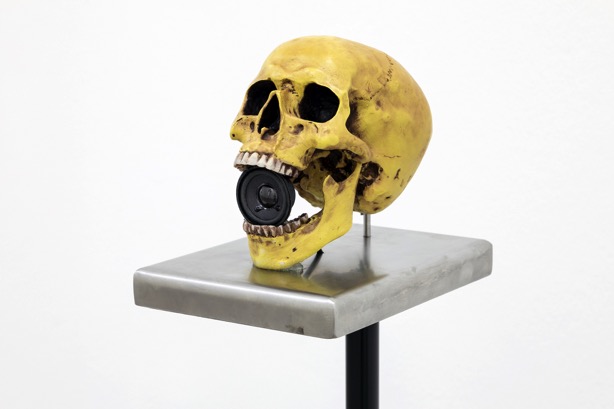
Roberto Pugliese
Logoranti e macabre perversioni resin, speakers, iron, audio playback system, composition
20 x 30 x 150cm
2019
On a pedestal a skull is anchored between whose teeth a loudspeaker is placed. The work is inspired by the adoption of skulls which is part of the Neapolitan tradition. In some catacombs "extra moenia" deaths were buried. Especially those of the plague of 1656 and those of cholera of 1865. Tragic epidemics that decimated the city and filled these places with anonymous remains, with bodies without identity to which to be buried. It was thought to save the living, and the bonds with the dead were abandoned, losing the private mourning of the loss. The relationship of the city of Naples with death is a question that arises on every corner. In Naples, death is the other side of life: you don't chase away, you team up to take advantage of it. Purging souls are the link with the afterlife, those who guide and protect those who are still alive. Hence, the practice still in use by some people to adopt and take care of some skulls, to which they give gifts and ask for thanks.
Starting from this tradition, the artist wants to create a work in which he returns word and sound to a skull, which, through a long electro-acoustic composition, returns some verses written by the artist at a young age.
A vivid work in its macabre perversion.
Roberto Pugliese
Logoranti e macabre perversioni resin, speakers, iron, audio playback system, composition
20 x 30 x 150cm
2019
Su un piedistallo è ancorato un teschio tra i cui denti è posto un altoparlante. L'opera si ispira all'adozione di teschi che fa parte della tradizione napoletana. In alcune catacombe furono sepolte morti "extra moenia". Soprattutto quelli della peste del 1656 e quelle del colera del 1865. Tragiche epidemie che hanno decimato la città e riempito questi luoghi di resti anonimi, di corpi senza identità. All’epoca si pensava a salvare i vivi e i legami con i morti furono abbandonati, perdendo il lutto privato della perdita. Il rapporto della città di Napoli con la morte è una questione che sorge ad ogni angolo. A Napoli la morte è l'altra faccia della vita: non scacci, fai squadra per approfittarne. Le anime che purificano sono il legame con l'aldilà, coloro che guidano e proteggono coloro che sono ancora vivi. Da qui la pratica ancora in uso da alcune persone di adottare e prendersi cura di alcuni teschi, ai quali fanno regali e chiedono grazie.
Partendo da questa tradizione, l'artista vuole creare un'opera in cui restituisca parola e suono a un teschio, che, attraverso una lunga composizione elettroacustica, restituisce alcuni versi scritti dall'artista in giovane età.
Un'opera viva nella sua macabra perversione.

